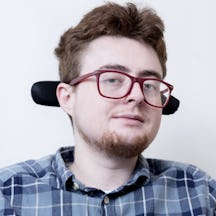What’s the point of audio-description at the theatre? In the first of a series of conversations with fellow performers from the disability arts scene, Jamie Hale explores the potential, power and politics of assistive technology for blind and visually impaired artists and audiences.
The politics and power of audio-description
Words by Jamie Haleaudio by Kirsten Irvingphotography by Christopher Andreouaverage reading time 7 minutes
- Article
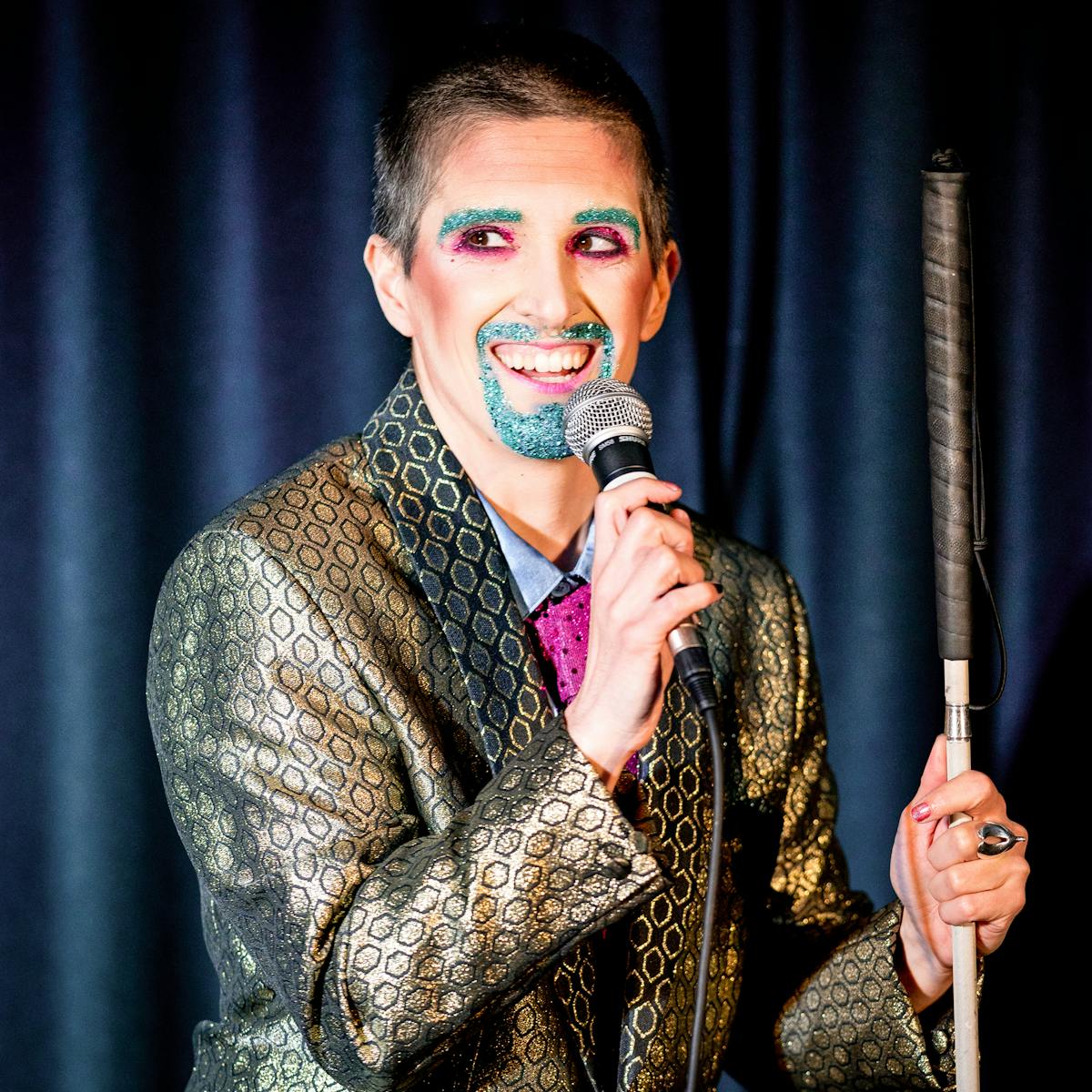
Listen
Tito pulls themself up the silks dressed as a 1980s aerobics instructor in neon and purple Lycra. Five metres above the stage, they let go, their torso teetering for a second before the red strands catch around their waist. Tito describes their actions to the audience as they perform, explaining how “Tito tries” all the things blind people are told not to do. Even as curator of the showcase they are performing in, I’m astounded by their act, from singing, to comedy, to the aerial silks.
I feel as if the disability arts scene in the UK is blossoming, with outstanding pieces such as ‘The Shape of the Pain’, emerging artists like Drag Syndrome, and festivals like Sick! and JOY. As I commissioned artists for a D/deaf and disabled artists’ showcase at the Barbican Centre last year – CRIPtic (at which Tito performed) – it became clear to me how much flux and innovation was happening at the intersections of disability art, science, technology and medicine.
Tito Bone is the drag king creation of blind multidisciplinary performance and audio-description artist Amelia Cavallo. Amelia is one half of Quiplash, a “queer crip access arts” company working on audio-description with organisations and individual creators. Tito’s act is rapid and engaging. The audience enthusiastically follows the aria they sing to their white cane, and the way they spin round the hanging silks.
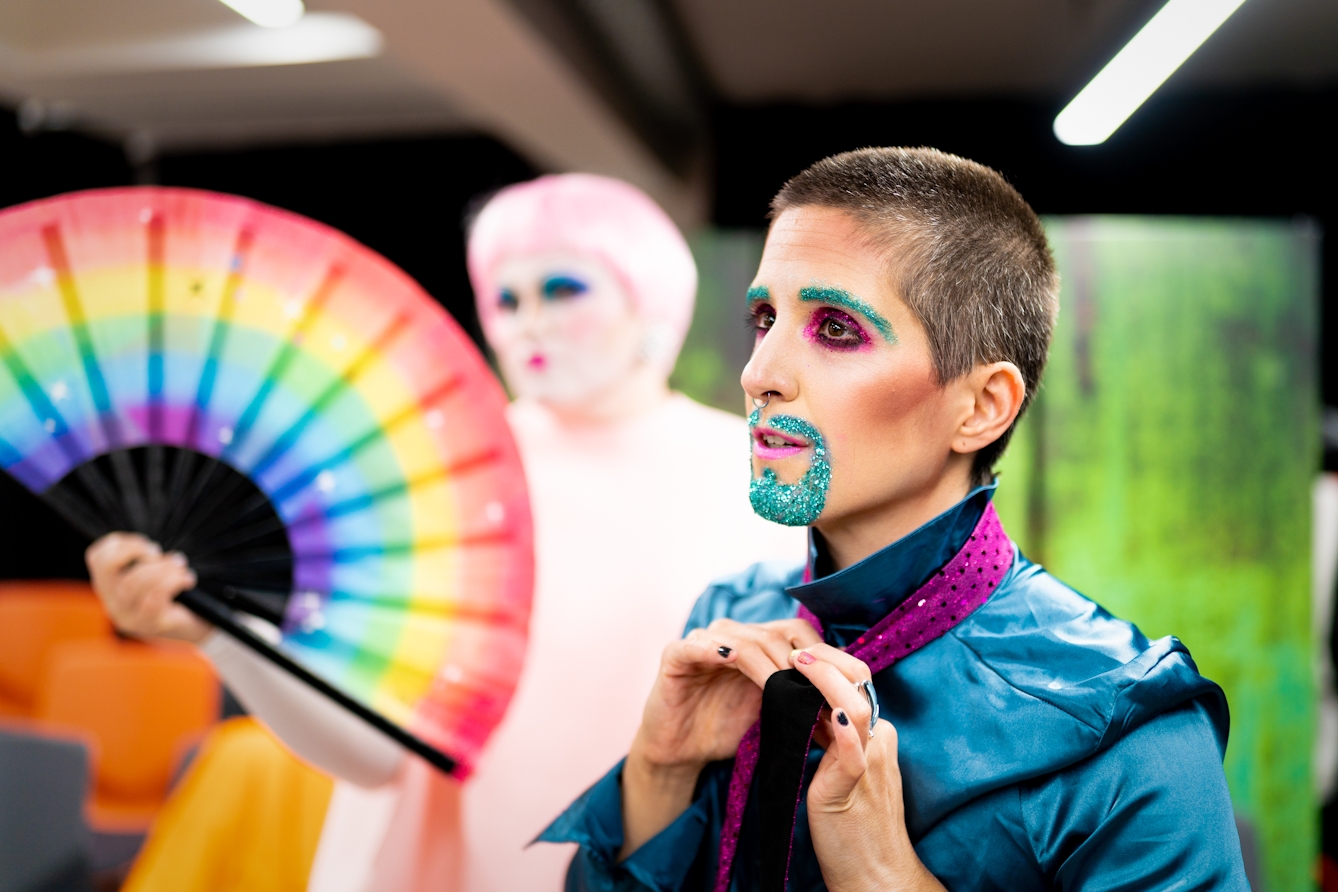
Tito Bone is the drag king creation of blind multidisciplinary performance and audio-description artist Amelia Cavallo.
Integrating audio-description
Audio-description has been transformative for blind people in accessing theatre. Traditional audio-description is delivered by trained, sighted audio-describers, and attempts to objectively describe what’s happening on the stage. It is broadcast into headsets, but users describe these as clunky, often broken, and physically separating blind audience members from sighted ones.
Listening to Tito’s patter as they perform, I realise they are subverting this model. Their description of their actions is fully integrated into the show and open to everyone. Talking to Amelia, they explain that this is “disrupting what is considered a ’normal’ way to interact with and process information”. This also makes Tito’s act far more financially accessible, not relying on expensive audio-description equipment.
Amelia cites Maria Oshodi, artistic director of Extant, as the inspiration behind their approach to audio-description. Maria is “the lead on integrated audio-description in the UK” and “made an entire theatre practice on using audio-description as a creative impulse for storytelling, character development and political radicalism”.
Speaking to Maria, she is clear that developing new technology is not the most crucial thing to consider when it comes to audio-description. However, depending on the show, she believes it has its place, and is excited about bone-conduction headsets, which could transmit audio-description without covering audience members’ ears. This would mean they could hear the rest of the show more clearly, and that the physical barrier between people using audio-description and the rest of the audience would be less noticeable.
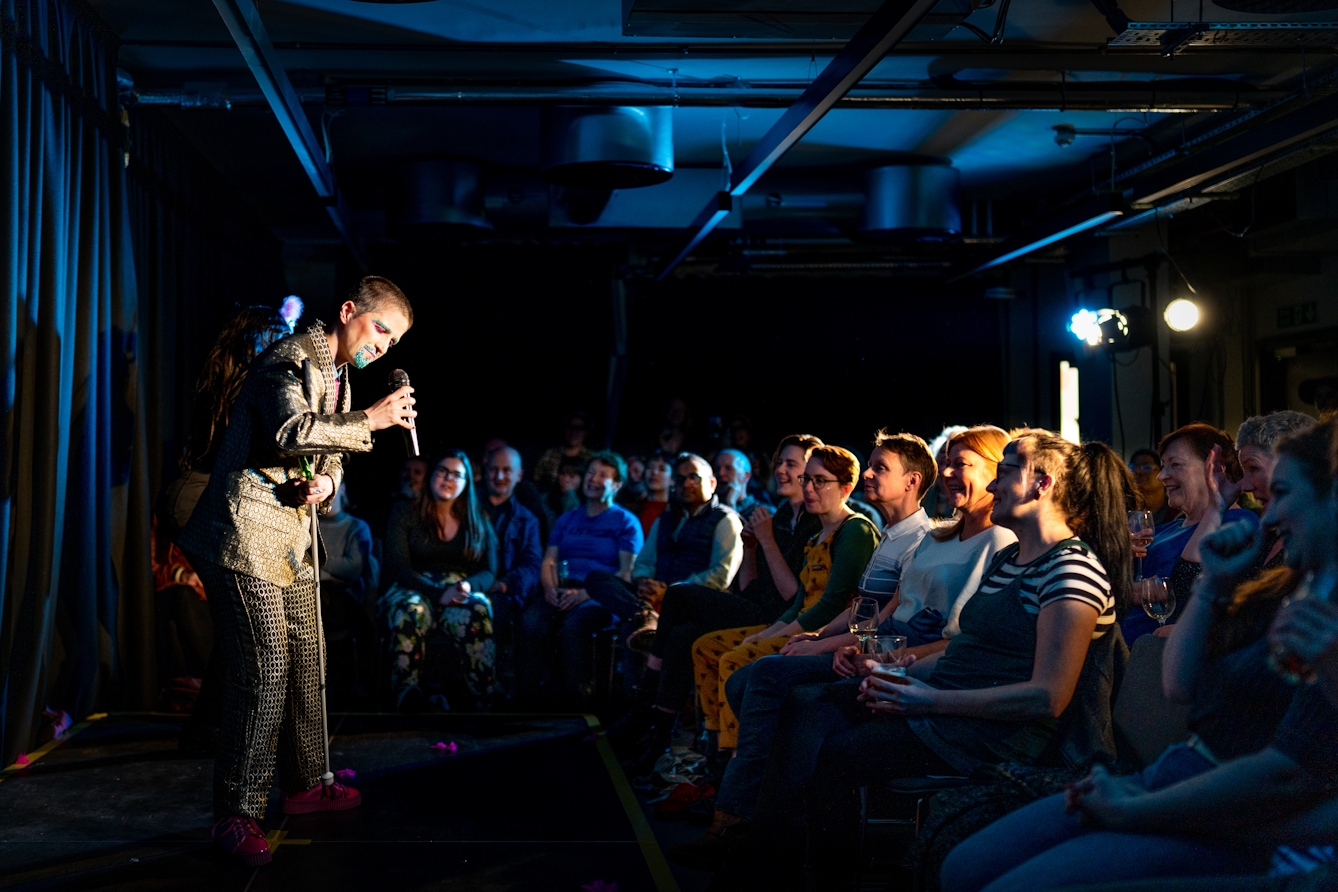
Tito Bone performing in 'Unsightly Drag!' at the Chapel Playhouse, London.
The low-tech options
Behind most styles of traditional audio-description is the implication that blindness is a deficit, and the point of audio-description is to make up for that – an idea that medicalises and individualises blindness and visual impairment. Rather than remedying a deficit, the reality is often that audio-description is making up for the fact that sighted people have created an inaccessible piece of work. The role of audio-description should be to provide what Amelia describes as “access to and agency over information that is a given for sighted people”.
Amelia and I discuss the high cost of both training in and booking traditional audio-description. They see this as classist, and too expensive for a lot of work produced by small companies, who disproportionately consist of people of colour, queer people and disabled people. One of the things Quiplash does is train audio-describers. They encourage the integration of audio-description into shows from the outset, and making it open instead of relying on unreliable headsets.
The reality is often that audio-description is making up for the fact that sighted people have created an inaccessible piece of work.
Amelia’s preference for low-tech open audio-description is political, highlighting the importance of making work inherently accessible from the outset rather than bolting on audio-description after the development. It also serves to make the audio-description visible to the whole audience, because everyone who can hear it, does. Amelia sees this as meaning “people have to challenge their idea of how they experience performance”.
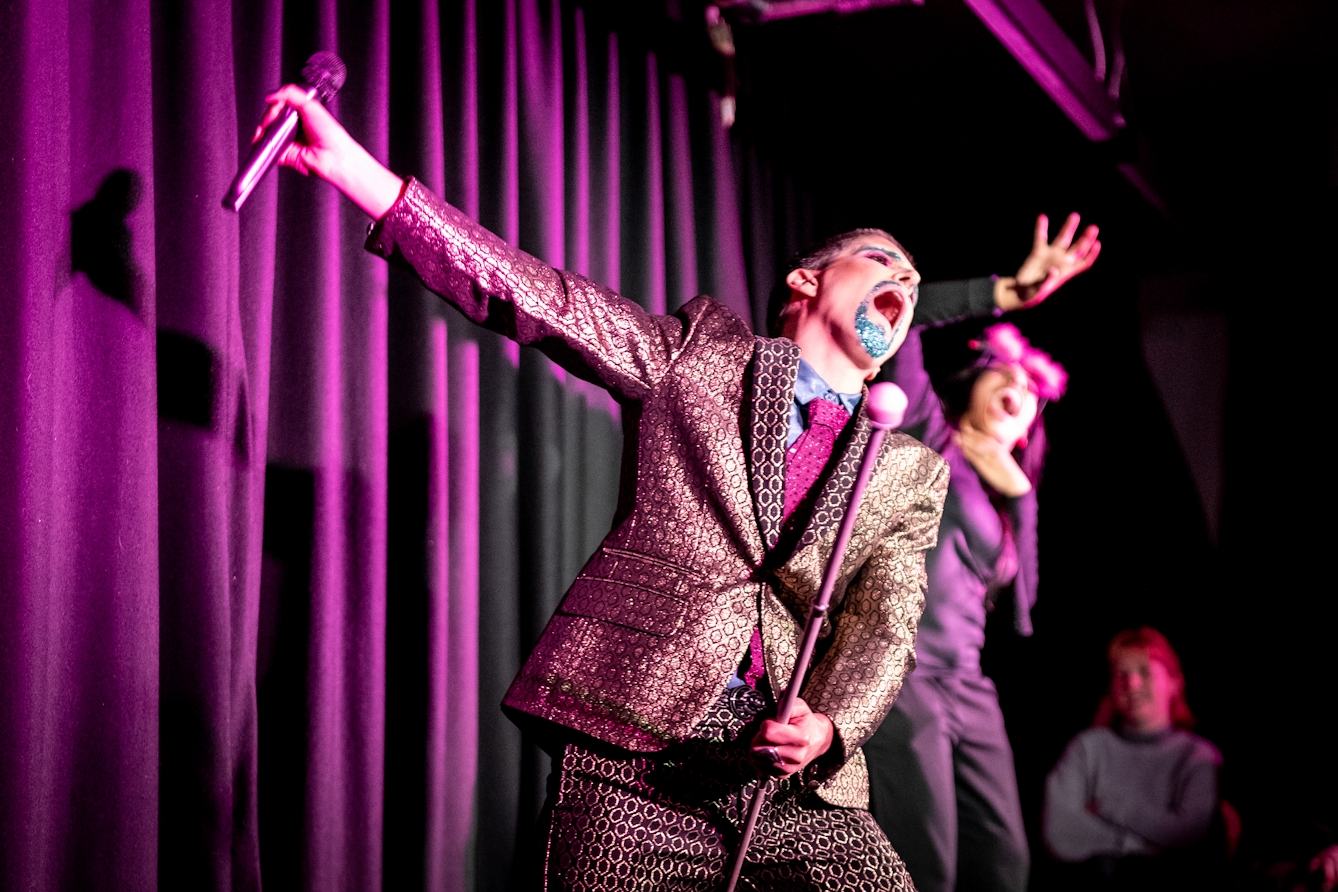
Tito Bone onstage in 'Unsightly Drag!'.
There are aspects of tech Amelia is strongly in favour of – such as powerful speakers that performers can carry with them on stage to amplify their voices from where they are in space. This would allow blind audiences to know a performer’s position, whether close to the audience or four metres in the air suspended from silks.
Method acting
From discussing aerial silks, our conversation turns to the audio-description of dance. Amelia recommends I talk to Nathan Geering, a hip-hop dancer, b-boy and choreographer, who is chief executive of Rationale. While not blind himself, Nathan is developing a series of artistic styles of audio-description called the ‘Rationale Method’ in a bid to create more accessible work. This uses subjective, emotive and poetic approaches to audio-description to make it more creative and engaging.
Rationale has also constructed a language for conveying physical movement. It relies on mapping beat-boxing and vocal percussion sound effects to the physical action that they best represent. This allows for dance and sport to be described rapidly and immediately, where describing each movement with text would take too long.
As theatres upgrade their technology, Nathan is excited about multi-channel audio-description, which lets audience members choose between styles of audio-description at the same show. It would allow for experimental methods of audio-description to sit alongside more traditional ones.
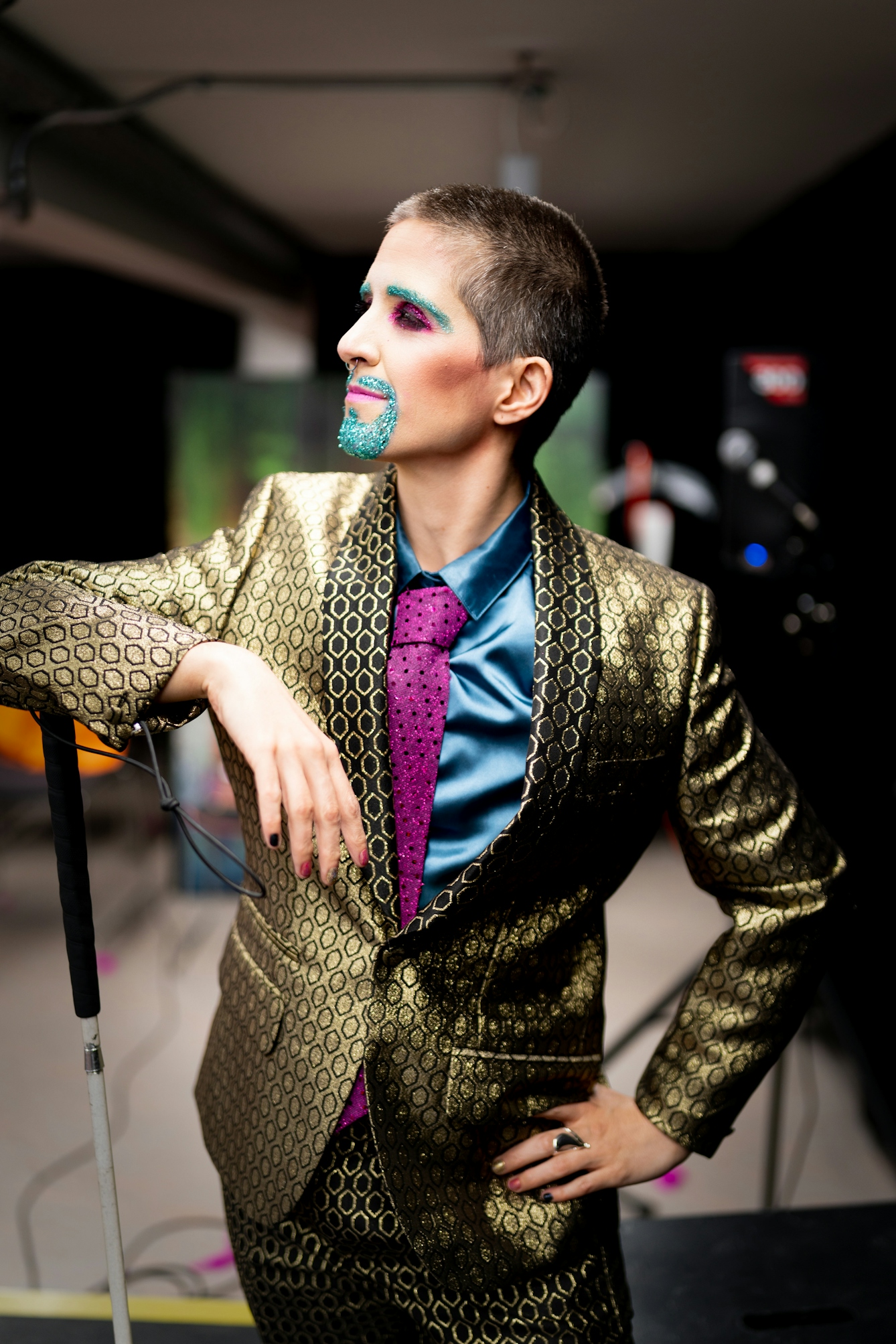
Tito Bone backstage at the Chapel Playhouse.
Disrupting the status quo
Through my discussions with Amelia, Maria and Nathan, a new approach for my own work has emerged. The solo poetry show I’ve developed about independence, illness, mortality and survival wasn’t accessible, even with a traditional audio-description script. Instead, I’m rewriting it to develop a second character, The Doctor. This doctor will provide a commentary, reflecting on my actions from a medical perspective, pathologising and individualising my experiences as a contrast to my political show. In doing that, he will both describe the action and add a layer to the show.
For my next show – where I’ll perform as a drag act called Mia Mortal – I’ve been considering how she can describe herself as she performs. My conclusion is that by reading the entries in her diary as she writes them, she will be able to describe her appearance and actions. Developing this description is challenging creative work, but has made me realise that for the audio-description to be effective, I have to integrate it into the creative aspects of my show from the very beginning.
Amelia, Maria and Nathan are all clear that the politics of audio-description need to change. The historical methods of audio-description developed by sighted people for blind and visually impaired people don’t necessarily give audiences what they need. When blind and visually impaired people develop audio-description for themselves (or are involved in the development of models such as the Rationale Method), transformative work emerges that uses fresh methods of communication to make theatre increasingly accessible.
As Amelia says, “Prioritising audio description… has the beautiful and often untapped potential to be both an extremely helpful and important access tool, and a means of radical activism that disrupts the status quo.”
About the contributors
Jamie Hale
Jamie is an artist, curator, and founder and artistic director of disability arts organisation CRIPtic Arts. They create poetry, comedy, scriptwriting and drama for page, stage and screen, and are currently directing a showcase at the Barbican Centre for autumn 2021 and a disability arts documentary. They have written for Wellcome Collection and the Guardian newspaper and have performed at venues including the Southbank Centre. Their poetry pamphlet, ‘Shield’, was published in January 2021.
Kirsten Irving
Kirsten Irving is a Lincs-born, London-based voice artist and poet. She has voiced work for a range of organisations including the Fairtrade Foundation, Royal Botanical Gardens Kew and the Women’s Institute, and can be heard on the Mosaic Science podcast.
Christopher Andreou
Christopher Andreou is a portrait and documentary photographer based in London. He rarely leaves home without a camera, taking inspiration from the streets of his home city, capturing candid moments and street portraits wherever he finds himself.
